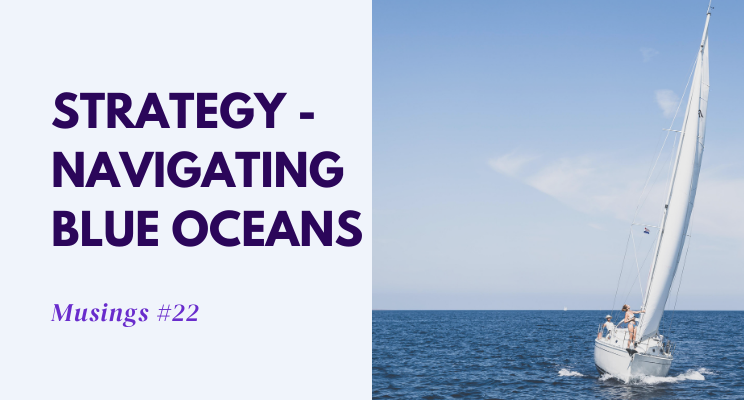I just finished watching the Star Wars series with my 12-year old, and it was a lot of fun. If you want to try it, here is the best sequence to watch it. It made me reminisce about borrowing VHS tapes and watching movies during my first few years in the US when weekend entertainment used to mean a stop at the local Blockbuster or Hollywood video to pick up a few movies from their stores for the weekend. I still vividly remember when Netflix was launched (I was an early adopter) – and it was such a breath of fresh air to add the movies I wanted to watch to a Netflix list, and the DVDs would magically show up at my doorstep in time for the weekend.
Today, I wanted to discuss how Netflix managed to create an entirely new category of online DVD rentals delivered home using the Blue Ocean Strategy lens. Before we dive into the Netlflix story, a quick note on Red Ocean vs. Blue Ocean. Red Ocean refers to the highly competitive markets where companies compete on existing parameters such as price, features, etc. Blue Ocean refers to when a company tries an entirely new way of servicing existing customers or expanding the customer base by a highly differentiated offering. Almost all of the large technology innovations we take for granted, such as products (smartphones, tablets, laptops, etc.) or services (ride-sharing, food delivery, e-commerce, etc.), are birthed by Blue Ocean strategies.
Now, back to my Blockbuster rental days. Blockbuster used to be ubiquitous in the 1990s with more than 9000 stores across the US. It had revenues of >$5 billion by the early 2000s, whereas Netflix was a tiny startup. Here’s a comparative graph of Blockbuster vs. Netflix. Netflix is now valued at over $200 billion, whereas Blockbuster is non-existent.
What did Netflix do well to create a Blue Ocean market? To answer this, we will use the two frameworks suggested by the authors of Blue Ocean Strategy. The Four Action Framework and the Strategy Canvas.
Four Action Framework
There are four key questions to answer from a buyer’s perspective for this framework, as outlined in the image.
Here’s what Netflix did across these four parameters to make a compelling offering and building a loyal customer base:
- Eliminate: Late fees (used to be my most significant pain point), Stores (unnecessary trip eliminated and cost savings for Netflix)
- Reduce: Impulse purchases (had to wait for the movie to come), Price per movie rented
- Raise: Selection (long-tail of movies available), duration of the rental (keep the DVD as long as you want – you will only get a new one when you return the one you had)
- Create: Home delivery of DVDs, Automatic dispatch of your next movie once you return the current one, the recommendation engine
Strategy Canvas
Strategy Canvas is a tool to look at the various parameters, again from a buyer’s perspective, and see which aspects we would like to Eliminate, Raise, Reduce or Create to make our offering unique to create a Blue Ocean. Here you give relative values to the various parameters to make appropriate trade-offs. Here is how Netflix did this (if you want a complete look at Netflix’s Blue Ocean Strategy, take a look here.)
Blockbuster’s problem is a common one for all incumbent businesses. It is a problem of the Innovators Dilemma, which Prof. Clay Christensen explains beautifully in this short video. Blockbuster had to disrupt its existing profitable and growing business of VHS/DVD rentals in stores (with late fees) to offer a completely new innovation (Netflix model) to its customers. But, that would have hurt its core business. Hence they allowed Netflix to disrupt them as highlighted in this deck (key chart below).
But, it wasn’t all bed of roses for Netflix. It had a thriving DVD rental by 2010 (and Blockbuster was on its way down), but its own video streaming service started taking off. It began to face competition from new entrants like Hulu (which was exclusively into streaming) and Amazon Prime Video. It had to choose between keeping its now healthy DVD rental business or going after the newer Streaming business. It tried launching a bundled approach (both DVD and streaming rental) and even tried spinning out DVD rental as a separate offering called Qwikster. Netflix’s legendary CEO Reed Hastings faced a lot of flack during this period (like this MIT Tech Review article here). But, in the end, Netflix managed to disrupt itself by switching focus to streaming (and dropping DVDs). Netflix managed to find another Blue Ocean in “Netflix Original Production.” They used data analytics to make a colossal company risking $100M bet in “House of Cards” that really paid off, leading to their leadership position in creating original content.
Core to Netflix’s success now over 20+ years is its ability to make sound strategic choices. But, how do we distinguish Good Strategy from Bad Strategy? Prof. Richard Rumelt has some great advice on this topic in “Good Strategy Bad Strategy.”. Let’s start with Bad Strategy and its six key characteristics:
- Avoids identifying the core problem
- Makes no hard choices
- Has no focus – conflicting goals
- List of outcomes (even audacious ones) – don’t make up a strategy.
- Does not build on the competence of the organization
- Cascading avalanche of fluffy Values, Mission, Vision, etc., which are not coherently put together.
Whereas on the other side, Good Strategy has three main components:
- Diagnoses – what are the core challenges
- Choices – what direction the company will take (and what it will stop) – guiding principles
- Action – Big picture action to move in that direction with focus – coherent action
Spotlight
Here is Prof. Rumelt talking about the principles from the book in this short 15-minute video.
To Ponder
- Can we draw out the Strategy canvas for our space? Are we in a Red Ocean, and if so, can we carve out a Blue Ocean?
- Do we have to disrupt ourselves out of the Innovators Dilemma to reach the Blue Ocean?
- Are we making any rookie mistakes of Bad Strategy?
(If you are enjoying Musings and find it helpful, please subscribe, and please share with friends who might find it useful.)
References:







